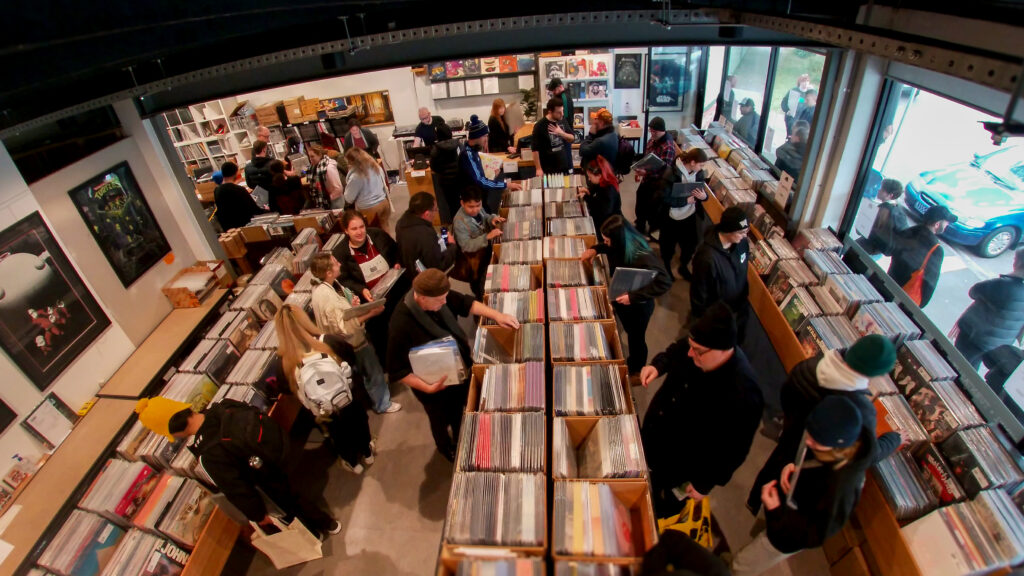In the case of English band TOY, nothing could be further from the truth. “No, it’s never been suggested that we’re a children’s band,” laughs bass player Maxim ‘Panda’ Barron. In fact, TOY’s music – a blend of ‘60s psychedelia, ‘70s Krautrock and early ‘90s shoegaze – is arguably diametrically opposed to what’s suggested by the band’s name. But in a Lewis Carroll sort of a way, the name is entirely appropriate. “We originally found the name from the side of an old toy box in a friend’s house,” Barron explains. “We really liked the logo and how it was used on the box, and the name just jumped out at us. And it had a really good meaning and connotations for us, so we decided to use it.”
The genesis of TOY can be traced back some years before the encounter with the Victorian toy box, to when most of the band members were attending the same high school in the seaside suburb of Brighton. “We formed about three years ago, but we went to school together before that,” Barron says. “Even before we formed the band, we played guitar together. We met our keyboard player [Alejandra Diezand], who’d just come back from Spain, in Brighton, and we met our drummer [Charlie Salvidge] in London.”
Raised on a musical diet of Television, The Stooges and the Velvet Underground, the young TOY did what most young bands do – they sat around in a rehearsal space, jammed, and created songs. “We just got in a room and started playing music,” Barron says. “Our keyboard player bought a Korg synthesiser, which has a really amazing sound – that’s what Roxy Music had in the ‘70s, and that helped form our sound. We’d grown up listening to Television and the Velvets, as well as bands like Can and Neu!, so we just spent a lot of time listening to music and thinking about ideas.”
The blend of Krautrock and psychedelia is, on one level, paradoxical – Krautrock is rooted in Germanic discipline, while psychedelia prides itself on its sonic and rhythmic elasticity. Upon closer examination, however, there’s a symbiotic relationship between the two genres.
“Krautrock generally has a straight, hypnotic beat,” Barron muses. “But even though Krautrock can be seen as monochrome, it can definitely take you to other places. We really like that heavy, hypnotic beat. And there’s plenty of Krautrock songs, especially from bands like Can, that are psychedelic.”
With each band member able to swap to different instruments if required, TOY has been able to take a collective approach to creating music. Barron says there’s no dominant artistic influence in the band. “I suppose it varies – everyone comes up with ideas,” he says. “We just take them into the studio, and we record live as well. And one of the good things in the band is that everyone can play other instruments.”
After recording a few singles, TOY signed to Heavenly Records, and went into the studio early last year to record the band’s debut self-titled album. “The guy we did the record with, Dan Carey, was a friend of ours,” Barron says. “When we were in the studio, he decided to set up a smoke machine and lasers. That created a swirly fog, and it helped create a different atmosphere that meant we didn’t have to concentrate on each take.”
TOY’s debut album made an immediate critical splash, generating positive commentary across the English music media. Despite the notoriously fickle tastes of the English media, Barron says TOY isn’t worried about any inevitable backlash. “We were really pleased at how the record was received over here,” Barron says. “We’re not that phased at the reviews, but it is nice when people say something nice about us. But I suppose it does wash off our backs a bit.”
In mid-June TOY will leave the northern summer for the southern winter (“it’s not much of a summer here at the moment,” Barron notes wryly) to undertake its first Australian tour. Barron says TOY’s live show is more than a replication of its recorded sound. “We’ve played the record live quite a bit, and when you’ve been playing the songs live for a while, the songs tend to morph into something different,” Barron says. “Our live show is different to the record – we’re not just trying to replicate the record. There’s quite a lot of room for improvisation in the songs. And while each show is different, it’s not a conscious thing to change it.”
BY PATRICK EMERY







